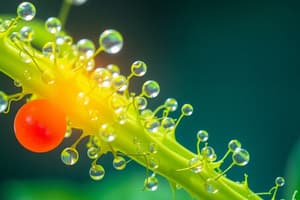Podcast
Questions and Answers
Plants use photosynthesis to make ____ for the plant
Plants use photosynthesis to make ____ for the plant
food
What do plants need in order to perform photosynthesis?
What do plants need in order to perform photosynthesis?
Plants need light, carbon dioxide, and water to perform photosynthesis.
How is the plant able to obtain each ingredient?
How is the plant able to obtain each ingredient?
Through the roots, pores, or holes in the leaves.
Identify the plant cell organelle in which photosynthesis takes place.
Identify the plant cell organelle in which photosynthesis takes place.
What happens to the oxygen that is produced as a result of photosynthesis?
What happens to the oxygen that is produced as a result of photosynthesis?
Why is photosynthesis also important for people and animals?
Why is photosynthesis also important for people and animals?
Why do both plants and animals need glucose?
Why do both plants and animals need glucose?
What are the three reactants needed for photosynthesis?
What are the three reactants needed for photosynthesis?
What are the two products of photosynthesis?
What are the two products of photosynthesis?
What are pigments?
What are pigments?
What pigments do plants have that help them absorb light energy?
What pigments do plants have that help them absorb light energy?
Why are plants green?
Why are plants green?
Definition of photosynthesis:
Definition of photosynthesis:
Definition of chloroplasts:
Definition of chloroplasts:
Definition of pigments:
Definition of pigments:
Definition of chlorophyll:
Definition of chlorophyll:
Definition of stomata:
Definition of stomata:
Definition of autotroph:
Definition of autotroph:
Definition of heterotroph:
Definition of heterotroph:
What is the difference between an autotroph and a heterotroph?
What is the difference between an autotroph and a heterotroph?
Flashcards are hidden until you start studying
Study Notes
Photosynthesis Overview
- Photosynthesis enables plants to produce food, primarily in the form of glucose.
- Essential ingredients for photosynthesis include light, carbon dioxide, and water.
Ingredients Acquisition
- Plants absorb water through their roots.
- Carbon dioxide enters through small openings called stomata on leaves.
Cellular Process
- Photosynthesis occurs in chloroplasts, the specialized organelles in plant cells.
- Chloroplasts contain chlorophyll, the pigment responsible for light absorption.
Byproducts of Photosynthesis
- Oxygen, a byproduct of photosynthesis, is released into the atmosphere.
- Glucose produced serves as an energy source for both plants and animals.
Importance of Photosynthesis
- Oxygen produced during photosynthesis is essential for the respiration of humans and animals.
- Glucose is crucial for ATP production, providing energy necessary for cellular functions.
Key Components
- Reactants needed for photosynthesis: carbon dioxide, water, and light energy.
- Main products of photosynthesis: oxygen and glucose.
Pigments and Their Role
- Pigments are colored compounds that absorb specific wavelengths of light.
- Chlorophyll, the main pigment in plants, absorbs blue and red light, giving plants their green appearance.
Definitions
- Photosynthesis: Process of using light to synthesize food.
- Chloroplasts: Green organelles in plant cells responsible for photosynthesis.
- Stomata: Openings on the underside of leaves for gas exchange.
- Autotroph: Organism capable of manufacturing its own food.
- Heterotroph: Organism unable to synthesize its own food.
Distinction
- Autotrophs create their own food, while heterotrophs rely on other organisms for nutrition.
Studying That Suits You
Use AI to generate personalized quizzes and flashcards to suit your learning preferences.




